Kevin O’Shea’s overtime winning goal in Game Seven of the 1972 NHL playoff quarterfinals is still one of the most exciting goals in St. Louis Blues’ history. The Blues hold the distinction of being the longest existing NHL team without a Stanley Cup championship to their credit. While they have had many dramatic moments since their inception in 1967 on up through the decades to follow, O’Shea’s goal to eliminate the Minnesota North Stars still decisively falls within the top-10 Blues’ playoff moments.
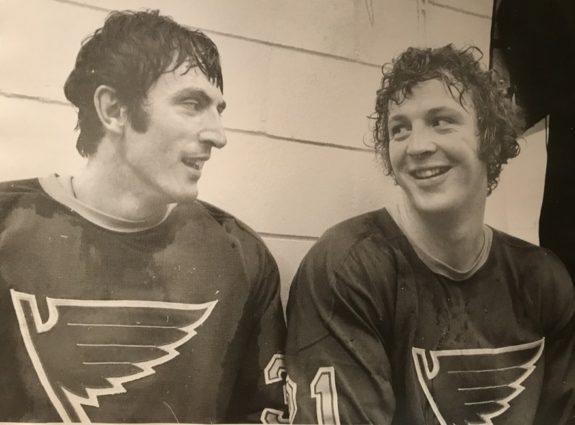
THW goes back in time to take a closer look at the goal that came off the stick of O’Shea. We will also examine the events leading up to it, and the composition of the 1971-72 St. Louis Blues’ roster. There are many interesting components to it, including two different sets of brothers, a Hockey Hall of Famer coach, and even a “Moose”.
Only a Few Original Blues Left
The Blues were one of the six new teams to join the NHL in 1967 as part of what was known as “The Great Expansion”. The league decided to double its size from its “Original Six” squads to an even dozen. St. Louis was joined by the Philadelphia Flyers, Oakland Seals, Pittsburgh Penguins, Minnesota North Stars and Los Angeles Kings as the six new teams.
All fledgling six were comprised in what was known as the Western Conference, with the “Original Six” – Detroit Red Wings, Montreal Canadiens, Boston Bruins, New York Rangers, Toronto Maple Leafs, and Chicago Blackhawks – playing in the Eastern Conference.
As is still the case in the NHL, when expansion teams are brought aboard an expansion draft is held in order to properly stock the new team(s) with assets. Though selection rules have varied over the decades, the concept has remained intact – expansion teams are able to select players from each of the already established teams.
Of the 33 different players to appear in the lineup for the 1967-68 inaugural Blues, only six remained on the 1971-72 team. One of those remaining six – defenseman Noel Picard – would only see action for 15 regular season games in 1971-72, and no playoff appearances. However, the other five – Frank St. Marseille, Gary Sabourin, brothers Barclay and Bob Plager, and Terry Crisp – all still fulfilled vital contributions to the team in its fifth season.
Stanley Cup-winning player – and eventually a Cup-winning coach – Al Arbour commanded the bench as the Blues’ head coach. As a player, he was also one of the original Blues and brought invaluable experience to the team no matter if he was on the ice or on the bench.
Keep in mind that with the assistance from how the NHL was structured after the 1967 expansion took place, the Blues had already made it to the Stanley Cup Final in three straight seasons. While they ultimately lost two of those Finals to Montreal and one to Boston, these same original Blues still acquired a great deal of experience in the process, and would provide necessary tutelage for the younger players to come.
So let’s look at the composition of the entire team.
1971-72 St. Louis Blues Roster
Defensemen brothers Barclay and Bob Plager had been joined in St. Louis by their younger brother Bill – an original Minnesota North Star – for four seasons straight beginning with 1968-69.
The trio of Plagers were tough as nails and brought a tremendous amount of heart to St. Louis. The 30-year-old Barclay was not only team captain, but led all Blues players in penalty minutes in 1971-72 with 176 in 78 games – the fourth highest total of PIMs in the NHL that season. Additionally, Barclay was the only Blues D-man to play in each game that season, and he led the entire St. Louis defense corps in scoring with seven goals and 22 assists for 29 points.
The Blues leading scorer that season was Garry Unger who was already on the way of setting the NHL’s mark for consecutive games played. He would eventually play 914 games straight – a mark later surpassed by Doug Jarvis. Unger led St. Louis with 70 points in 78 games and a team-high 36 goals as well.
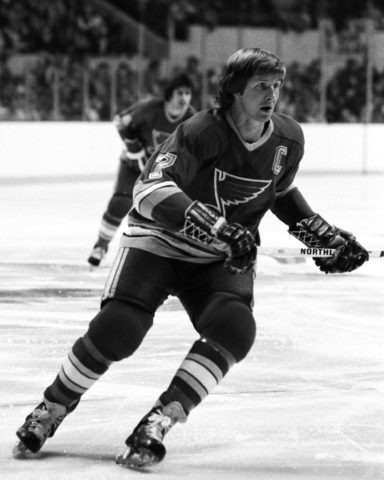
The veteran St. Marseille would finish second in scoring with 52 points of his own in 78 games. His 36 assists were the most helpers for the Blues.
Aside from the established veterans, the Blues had some key youngsters on the squad as well. Playing in his rookie NHL season, 21-year-old Mike Murphy potted 20 goals in 63 games. Another rookie, defenseman Andre “Moose” Dupont, would eventually go on to win two Stanley Cups with the Philadelphia Flyers. In this instance however, he was playing in his first full NHL season after a handful of games with the Rangers the year prior. Dupont was second to Barclay Plager in penalty minutes with 147 in 60 games. First-year player Brian Lavender would also see both regular season and playoff action.
Five different goaltenders would man the crease for St. Louis through the course of the season. Handling the bulk of the duties was the tandem of Jacques Caron and Ernie Wakely. Caron’s 2.52 goals-against average and his record of 14-8-5 across 28 games were tops among all St. Louis goalies. An interesting third helper was netminder Jimmy McLeod who at 34 years old was playing in his first and only NHL season. McLeod played in 16 games and posted a record of 6-6-4.
Key Trades and the O’Sheas
The Blues did a very solid job of bolstering their 1971-72 roster via key trades during the course of the season.
The most notable was the acquiring of Murphy, Dupont and Jack Egers from the New York Rangers on Nov. 15, 1971 by trading away Wayne Connelly, Jim Lorentz and Gene Carr. While we have already made mention of Murphy and Dupont, it was Egers who best helped the St. Louis offense. After just two goals in 17 games for the Rangers, Egers would finish third in scoring for the Blues as he contributed 21 goals and 25 assists in 63 games after coming over in the trade.
The next key maneuver that the Blues performed was obtaining seldom-used winger Phil Roberto from the Montreal Canadiens on Dec. 13, 1971 in exchange for veteran winger/defenseman Jim Roberts. Roberto had not seen a whole lot of action in Montreal, but did win the Stanley Cup with them the season prior. After putting up just five points (3G, 2A) in 27 games for the Habs, Roberto would end up scoring 12 goals and 13 assists in 49 games in St. Louis. More importantly, he would end up being St. Louis’ best offensive threat once the playoffs got underway.
Here is where our tale begins to incorporate a second set of brothers, the O’Sheas, and the hero of our story.
An Irish family and with bright red hair, the O’Sheas hailed from Ontario – Danny was born in Ajax, while Kevin was born in Toronto. The Blues first traded for the older of the two, Danny. Through his first three seasons in the league with the North Stars and Blackhawks, Danny had scored double digits in goals each season. On Feb. 8, 1972, St. Louis sent center and Stanley Cup champion Christian Bordeleau to Chicago in order to get the older O’Shea.
Perhaps seeking a brotherly connection similar to what they already had with the Plagers, the Blues made a grab of Kevin O’Shea right before the 1971-72 postseason got underway. On Mar. 5, 1972, the Blues claimed the younger O’Shea from the Buffalo Sabres off of waivers. The move to acquire him would ultimately spell opening round victory.
A Quick Look at Kevin O’Shea
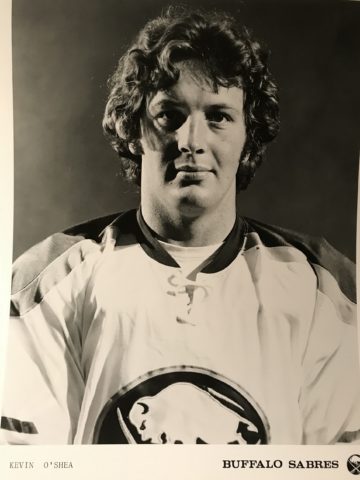
Kevin O’Shea had been an original member of the Buffalo Sabres when they were brought into the NHL for the 1970-71 season alongside the Vancouver Canucks.
Prior to his professional career getting underway, the younger O’Shea played two seasons of college hockey at St. Lawrence University in New York State. He would end up making his professional debut during the 1969-70 season with the San Diego Gulls of the old Western Hockey League. One of O’Shea’s teammates with San Diego was Hockey Hall of Famer and the NHL’s first black player, Willie O’Ree.
With an interest in adding young talent to their upcoming roster, the Sabres claimed O’Shea in the Inter-League Draft on Jun. 9, 1970. He would play in Buffalo’s first regular season game when they defeated the Pittsburgh Penguins on the road by a score of 2-1.
More noteworthy however is that O’Shea earned the primary assist on Gilbert Perreault’s game-winning tally in the third period. Often overlooked or forgotten, O’Shea is in the history books for setting up the first game-winning goal in Buffalo Sabres’ history and the very first goal in Perreault’s Hockey Hall of Fame career – the first of 512.
In 93 games as a Buffalo Sabre, Kevin O’Shea scored 10 goals and 13 assists for 23 points.
After coming over to St. Louis on waivers, he ended up playing in all of four games as the 1971-72 regular season wound down. It would be a different story come the playoffs.
Heading Into the ’72 Playoffs
In order to distribute things more fairly and to better place teams for geographical purposes, the NHL restructured their two conferences after Buffalo and Vancouver were added to the league.
That being the case, the 1971-72 Blues finished in third place in Western Conference with a record of 28-39-11 for 67 points. Only the top four teams in each conference made the playoffs. The Blues were joined by Chicago (107 points), Minnesota (86) and Pittsburgh (66) who just eked out Philadelphia because of goal differential.
The opening round matchups saw the Blackhawks face the Penguins, while the Blues took on the North Stars. While the Blackhawks made very short work of the Penguins – sweeping them in four straight games and limiting them to only eight goals – the Blues and North Stars went the distance.
We will offer details from all seven games of the series, leading up to O’Shea’s heroics in Game Seven:
Apr. 5, 1972 – Game One
The Blues played on the road in Minnesota at the Met Center. Unfortunately, they did not jump out of the gate very well. Minnesota badly out-shot St. Louis 44-27 on their way to a 3-0 victory. At 42 years old, Hockey Hall of Famer Gump Worsley earned the shutout for the North Stars. Were it not for the heroics of Blues’ goalie Jacques Caron who made 41 saves, the score could have been much more lopsided. As it stood, Minnesota received two goals from Dean Prentice and one from Bob Nevin.
Apr. 6, 1972 – Game Two
The very next day the Blues would give a better showing for Game Two, but still came up short. Turning the tables a bit on Minnesota, St. Louis did the out-shooting this time, 38-29. Playing like a man possessed, St. Marseille led both teams with eight shots on goal. He promptly scored a hat-trick to help lead his club, as Blues skaters peppered North Stars’ goalie Cesare Maniago. Egers (six) and Roberto (five) had plenty of shots of their own, while “Moose” Dupont’s four were the most rubber fired by either team’s defenders.
The difference came down to goaltending. With Wakely taking over the duties from Caron, he allowed six goals on only 29 shots. The Blues obviously needed him to have been better.
The game would go to overtime where Minnesota’ Bill Goldsworthy needed just 1:36 into the extra session to give his team the win and put the North Stars up 2-0 in the series.
Apr. 8, 1972 – Game Three
In danger of going down 3-0 in the series, the Blues fought their way to a 2-1 victory on home ice. Caron and Worsley were back in the nets, and remained brilliant for both teams. Caron turned aside all but one of the 30 shots he faced from Minnesota, while Worsley made 33 saves of his own.
Roberto scored a goal in the first and second periods, and Murphy assisted on both tallies. Even though Minnesota’s Jude Drouin scored for his team just 40 seconds into the third, his team could not muster a comeback.
St. Marseille continued to be a workhorse for the Blues. Though he failed to get onto the score sheet, he still put seven shots at Worsley. In three games he had taken 16 shots on goal.
Apr. 9, 1972 – Game Four
St. Louis would even the series the very next day to make it 2-2 by getting a 3-2 victory. While the North Stars would go back to Maniago in goal, St. Louis made the wise decision to stick with Caron.
Minnesota took a 2-0 lead in the game thanks a first period goal from Drouin, followed by a second frame tally from eventual 50-goal scorer Danny Grant.
Backed by Caron’s goaltending, the Blues went unfazed and rallied. Roberto got them on the board first with an unassisted goal, cutting the lead by one. Not even two minutes later, Kevin O’Shea struck with his first goal in a Blues’ uniform to tie the score. Bob Plager and Crisp picked up the helpers on O’Shea’s goal.
With the score tied 2-2 in the third period, Barclay Plager struck on the power play while Minnesota’s Dennis Hextall was in the box for interference. Roberto and Unger would get the assists to put each of them with three assists apiece in the series. At this point Roberto had compiled seven points in four games.
Apr. 11, 1972 – Game Five
While they may have tied things up, the Blues simply could not pull ahead in the series. Now back in Minnesota, they lost a closely contended game to the North Stars by a 4-3 score.
The two teams would trade goals back and forth all game long. North Stars defenseman Barry Gibbs opened the scoring less than two minutes into the game with his first of the postseason. Nearly 15 minutes would pass until St. Louis’ Sabourin tallied from St. Marseille to make it one-all.
Before the period was out, Tom Reid put Minnesota back into the lead again just over a minute after Sabourin’s goal. However, with just one second left in first, Roberto scored his fifth of the playoffs from Egers and Sabourin. It was a power play goal while Goldsworthy was in the box on a slashing minor.
Nearly an entire period would go by with the two teams deadlocked at 2-2. With Reid in the box due to an elbowing infraction, Unger struck on the power play for St. Louis with 26 seconds remaining in the second.
Even though the Blues led 3-2, the North Stars would score two early goals in the third period. J.P. Parise scored unassisted while on the man-advantage at 2:55. Goldsworthy would then set up a score from Drouin at 5:45. Minnesota would maintain the lead and earn the win from there.
Apr. 13, 1972 – Game Six
In Game Six the Blues were facing elimination but had the advantage of being back home. At no point during the contest would the Blues fall behind, although Minnesota would not make it easy.
With the North Stars’ Charlie Burns in the box early on because of interference, Roberto scored his sixth of the playoffs at the 3:04 mark. Only 59 seconds later though Goldsworthy would knot one to tie the game 1-1.
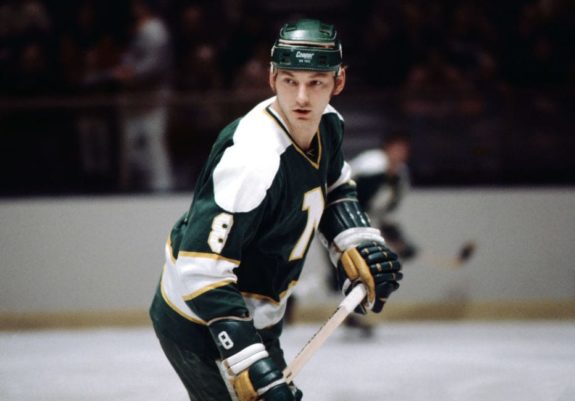
St. Louis would get two straight goals from there – one from Bob Plager before the close of the first and one from Unger in the second.
Parise’s score at 15:01 in the third narrowed the lead, but St. Louis was not to be denied. Egers would add an insurance goal from St. Marseille and Barclay Plager with 3:47 remaining in regulation.
Combined with Caron turning aside 28 of the 30 shots that he faced, the Blues would stave off elimination and force Game Seven back in Minnesota.
Apr. 16, 1972 – Game Seven
The seventh game of the series was played very tightly, and the two teams had rather similar performances. Caron and Maniago were the two netminders for the final showdown and the amount of work that each faced was rather even. The Blues took 27 shots as opposed to the North Stars 29.
Even the penalties ended up being evenly distributed as both teams had five 2-minute minor infractions each. Though 10 different penalties were called during regulation, neither team would score with the man-advantage.
The first goal went to the Blues. Sabourin beat Maniago at 12:04 of the opening period. The assists would go to Bob Plager and St. Marseille. The Blues appeared poised to take a 1-0 victory, as they kept Minnesota at bay for the rest of the first period and all of the second.
Just 15 seconds into the third, 36-year-old Charlie Burns scored his first goal of the playoffs to tie the game for Minnesota. Ted Harris – a defenseman who would retire as a 5-time Stanley Cup champion – picked up the assist on the goal. Both Caron and Maniago would turn aside shots for the remainder of regulation.
Now needing an extra session to decide the winner, the game could have gone either way. That is when Kevin O’Shea came into the picture.
10 minutes into overtime, the North Stars tried to carry the puck into the St. Louis zone. The play would be broken up and sent back out by seldom-used Blues defenseman Larry Hornung. After Hornung pushed the puck back out, Crisp corralled it and flung a backhand pass from along the boards to center ice. There it was picked up by a streaking Danny O’Shea. Carrying the puck over the blue line, O’Shea fed a pass across to his younger brother who was coming up the right side.
Not even taking another stride, Kevin O’Shea wired a slap-shot from the point. Maniago stretched out his right pad and stick, but O’Shea’s shot had too much mustard on it. Before Maniago could even fully react, the puck was in the back of the net.
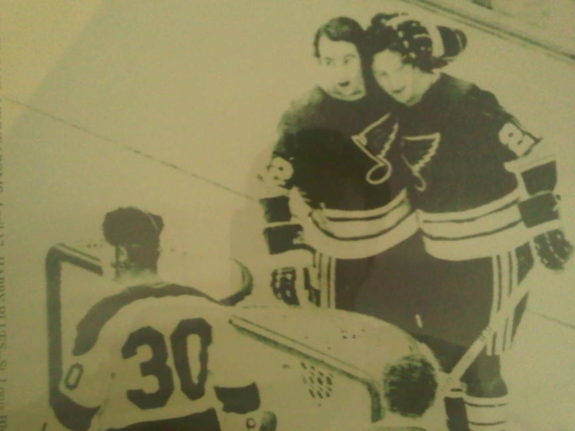
Kevin O’Shea skated around the back of the Minnesota net and quickly looked all around for a teammate to celebrate with. Brother Danny soon joined him and put his arm around his younger brother, scruffing up the hair on top of his head. Crisp came and wrapped his arms around both brothers, and soon the rest of the Blues followed suit.
Fleeting but Memorable for All
While Kevin O’Shea’s goal indeed brought St. Louis elation, it would ultimately be fleeting.
With the way the NHL playoff format worked at the time, there was a crossover between the Eastern and Western Conference teams for the second round. The Chicago Blackhawks would face the New York Rangers, while the Blues took on the heavily favored Boston Bruins.
“The Big, Bad Bruins” roster was utterly a powerhouse. Bobby Orr, Phil Esposito, Gerry Cheevers, Johnny Bucyk, Derek Sanderson, John McKenzie, and so on and so forth. The 1971-72 Bruins only lost 13 games all season as compared to St. Louis’ 39.
Boston would sweep the Blues in four straight games. In the process, Boston scored 28 goals against St. Louis through the four contests but only allowed eight.
Eventually, the Bruins would go on to win the Stanley Cup over the Rangers in six games.
Never to Forget Kevin O’Shea
As for our hero Kevin O’Shea, he played only one more NHL season after this. Back with St. Louis, he would split the 1972-73 season between playing for the Blues and the WHL’s Denver Spurs.
O’Shea followed that up with three seasons in three separate leagues. He would be a member of the WHL’s Phoenix Roadrunners for the 1973-74 season. The WHA’s Minnesota Fighting Saints would receive his services in 1974-75 for a lone campaign. Lastly, O’Shea even played a season in Sweden with Timrå IK for 1975-76 where he established a then all-time penalty minute record of 72 PIMs in 33 regular season games.
It is important to note that O’Shea won a Lester Patrick Cup – the WHL championship trophy – while playing for the Roadrunners in those final seasons of his career. In just 54 games that season he scored 24 goals and 21 assists. En route to the Cup, he tied with teammate Bob Barlow for leading Phoenix in playoff scoring with six goals and five assists in nine games.
Very sadly, Kevin O’Shea passed away on Jan. 18, 2010. He died of heart failure at the age of 62.
While O’Shea may be gone, his memory will forever live on in the annals of hockey history. Furthermore, his Game Seven OT-winner will forever be an important piece of St. Louis Blues hockey lore. For those fortunate enough it to have seen it happen, it probably feels that it happened just yesterday.